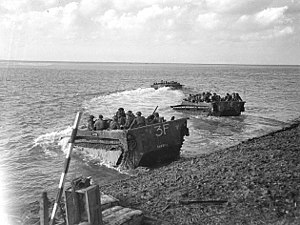Battle of the Scheldt
| Battle of the Scheldt | |||||||
|---|---|---|---|---|---|---|---|
| Part of World War II | |||||||
 Buffalo amphibious vehicles taking Canadians across the Scheldt in Zeeland, 1944. |
|||||||
|
|||||||
| Belligerents | |||||||
|
|
|
||||||
| Commanders and leaders | |||||||
|
|
|
||||||
| Units involved | |||||||
| Canadian 1st Army | German 15th Army | ||||||
| Strength | |||||||
| 60,000 | 90,000 | ||||||
| Casualties and losses | |||||||
| Canadian: 6,367 Total: 12,873 |
Roughly 10-12,000 41,043 captured |
||||||
The Battle of the Scheldt was a series of military operations by the Canadian First Army - consisting of Canadian, British and Polish formations - to open up the port of Antwerp so that it could be used to supply the Allies in north-west Europe. Led by Guy Simonds, the battle took place in northern Belgium and southwestern Netherlands during World War II from October 2 to November 8, 1944.
The well-established Wehrmacht defenders staged an effective delaying action, during which the Germans flooded the Scheldt Estuary, slowing the Allied advance. After five weeks of difficult fighting, the Canadian First Army at a cost of 12,873 Allied casualties (half of them Canadian) were successful in clearing the Scheldt after numerous amphibious assaults, obstacle crossings, and costly assaults over open ground. Both land and water were mined, and the Germans defended their line of retreat with artillery and snipers.
Once the German defenders were no longer a threat, it was a further three weeks before the first convoy carrying Allied supplies was able to unload in Antwerp (on November 29, 1944) due to the necessity of de-mining the harbours.
By September 1944, it had become urgent for the Allies to clear both banks of the Scheldt estuary in order to open the port of Antwerp to Allied shipping, thus easing logistical burdens in their supply lines stretching hundreds of miles from Normandy eastward to the Siegfried Line.
Since the Allied forces had landed in Normandy (France) on D-Day, June 6, 1944, the British Second Army had pushed forward into the Low Countries and captured Brussels (3–4 September) and Antwerp, the latter with its ports still intact. But the advance halted with the British in possession of Antwerp, while the Germans still controlled the Scheldt Estuary.
...
Wikipedia
